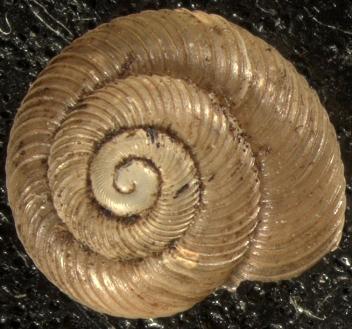Classification
The scientific name of this land snail is Discus cronkhitei (Newcomb). It is more commonly known as the Forest Disc. Over time, this scientific name has changed many times. In 1919 it was called Pyramidula cronkhitei, in 1967 it was called Discus cronkhitei, then in 2008 it was decided that the true name is Discus whitneyi (Hendricks, 2009). For the sake of this website, however, it will be referred to as Discus cronkhitei (Newcomb).
According to the Integrated Taxonomic Information System (ITIS), the current taxonomic status of the name Discus cronkhitei (Newcomb, 1865) is invalid. As stated above, the valid name for this species is now Discus whitneyi (Newcomb, 1864). The name change happened because originally scientists thought they were separate species, but after some time it was realized that the same species had two different names. According to Article 28 of the International Rules of Zoological Nomenclature, "in cases of synchronous synonymic names, that selected by the first reviser shall stand" (Pilsbry, 1939-1948). Since Discus whitneyi was name given first, that is now the valid name.
The Latin meaning of discus is literally "disc." It is also similar to the Greek diskos, which means disc as well. They get this name because their shell is so flat that it almost looks like a disc (Martin, 2000). There is no Latin meaning for either cronkhitei or whitneyi. The name whitneyi is named after Professor Whitney, patron to the California Academy of Natural Sciences in San Francisco, so one could conclude that there is a Professor Cronkhite somewhere that cronkhitei is named after (Livinglandscapes). The common name for Discus cronkhitei is the Forest Disc. Although no sources really stated the origin of this name, it can be concluded that since this species is commonly found in hardwood forests, and has a disc shaped shell, that Forest Disc would be a logical name.
Domain: Eukarya
~classified by having a genetic material (DNA) contained in a
nucleus and membrane bound organelles.
Kingdom: Animalia
~classified by being multicellular and heterotrophic.
Superphylum: Lophotrochozoa
~classified by having either a lophophore or trocophore larva.
Phylum: Mollusca
~classified by having a soft coelomate body with a
mantle, visceral mass, and muscular foot.
Class: Gastropoda
~classified by having a single shell of calcium carbonate,
coiling, torsion, head and foot.
Subclass: Pulmonata
~classified by having a lung open to the outside by a
pneudostome to obtain oxygen. All species are monoecious.
Order: Stylommatophora
~classified by having a long pedal gland under a membrane and
tentacles that can be retracted. (reference.com)
Family: Discidae
~classified by moderately flattened shells and are found in
colonies in most cases because they are social. This
family is considered Holarctic. (Martin,
2000)
Genus: Discus - Fitzinger, 1833
~classified by being small (5-7 mm wide), with much flatter
shells than other relatives from the Discidae family. (Martin,
2000)
Species: Discus cronkhitei (Newcomb, 1865)
~classified by small depressed shell (7 mm max) that is a light
brown color. The first 1 1/2 whorls are smooth. Farther
out, ribbing is strong and more apparent. It has rapidly
increasing whorls, usually 3 1/2-4 1/2 total whorls. (Pisbry,1939-1948)
Information about Eukarya-Pulmonata from (Hickman,
2009).
Want to learn about the Habitat of
Discus cronkhitei?
Or go to the Home page.